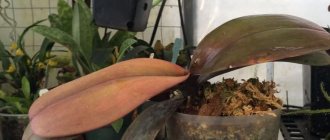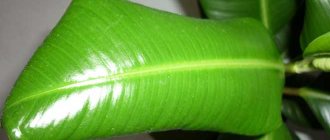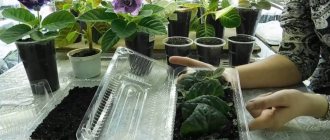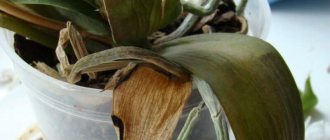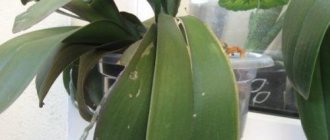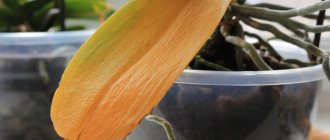Microclimate disturbance
In the vast majority of cases, the deformation of orchid leaves is a response of the plant to the conditions of its maintenance, or rather, to mistakes in care . As practice shows, achieving perfection without taking into account the developmental characteristics of a particular plant is not realistic.
Possible causes of leaf deformation in an orchid due to non-compliance with maintenance conditions:
| Causes of sheet deformation | Errors in care | Control and prevention measures |
| Hypothermia | Draft, drop in average daily temperature below +12-15°C | Restore the optimal temperature regime, treat the plant with the anti-stress drug “Kendal” or “Zircon” |
| Thermal shock | Perhaps the leaves touch the window glass, the surface of which is cold in winter and hot in summer | Move the pot to the edge of the window sill, create a barrier between the glass and the plant |
| Oxygen starvation of the root system | Lack of air access to the roots due to increased density and humidity of the substrate | Adjust watering, replace the decomposed substrate with fresh and loose one |
| Nitrogen, potassium or phosphorus starvation | Lack of mineral nutrition | Fertilize regularly, choosing special fertilizers for orchids |
| Dry air | Reducing atmospheric humidity below 40% | Monitor air humidity |
Curling of leaves, accompanied by loss of turgor, is usually caused by a lack of moisture.
Household air humidifiers help maintain humidity at an optimal level for orchids. If it is not possible to install such a device, you can increase atmospheric humidity using the following methods:
- place the pot with the plant in a tray with wet filler (expanded clay, pebbles);
- cover the orchid with damp moss;
- regularly irrigate the foliage with a fine spray, avoiding moisture getting on the flower stalks and in the axils of the leaves;
- place the plant next to an aquarium or decorative fountain.
What to do to save a wilted orchid
Ways to save an orchid if it has wilted depend on the cause of the flower wilting. The main thing is to notice the problem in time and correctly recognize it in order to cure the plant.
Transplantation as a treatment method
You can replant a flower when insects or diseases appear. But you need to take into account that replanting is stressful for a house plant, so it cannot be done often.
In what cases is it necessary to replant an orchid:
- nematodes, thrips and other pests appeared in the soil;
- the roots began to rot and the leaves began to become flabby due to improper care;
- the soil began to resemble dust.
Important! To replant, you need to purchase a special substrate for orchids.
How to make a transplant correctly:
- If the orchid has recently stopped blooming, the flower stalks are cut off. The lower leaves, if they are dry, can also be cut off.
- Before transplanting, all tools and the pot are disinfected.
- The orchid is carefully removed from the old pot, being careful not to damage the roots.
- Under running water, wash away the remaining soil from the roots.
- Then the root system is carefully examined. If pests are present, the plant should be immersed in warm filtered water for several hours. Then the roots are treated with fungicides against insects.
- Flabby, rotten and dried roots are cut off.
- The cut areas are sprinkled with crushed activated carbon or an antibacterial agent.
- Soft and wrinkled bulbs are also trimmed and the cut areas are treated.
- If the flower has well-developed aerial roots, they do not need to be deeply buried in the soil. Also, do not compact the soil too much; the roots will fix themselves in the substrate after a while.
Note! You can replant the orchid into a new pot only after the roots have dried thoroughly. This takes about 8 hours.
Light intensity
When growing indoor orchids, sunlight plays a key role . All kinds of diseases and developmental disorders, including leaf deformation, arise due to improperly organized lighting conditions.
- Inconsistency of lighting intensity with the biological characteristics of the plant . Orchids are divided into shade-tolerant (Phalaenopsis, Cambria) and light-loving (Vandas, Cattleyas, Cymbidiums, Angrecums), and require an appropriate approach to choosing a place of growth - on the shady or southern side of the room.
- Exposure of the plant to direct sunlight . Even light-loving orchids only require diffused light.
- Reducing daylight hours. The optimal duration of lighting is at least 12 hours, and for young plants 16-18 hours a day. In the dark season, artificial lighting is necessary.
I would like to draw the attention of orchid lovers to the fact that the fact that an orchid belongs to the light-loving group does not mean that it can withstand direct sunlight. An orchid should be accustomed to the spring sun gradually. Already in March, plants located on windows with southern and southeastern exposure need to be shaded. When the plant adapts, it will be enough to lower the curtains or close the blinds only during the midday hours.
Author of the book “Caring for Indoor Plants” Elena Ustinova.
Why do orchids have limp leaves?
Although orchids require certain conditions of maintenance and care, they have a high degree of survival. Therefore, even the most hopeless flower, which has lost most of the root system or foliage mass, can be reanimated. Establishing the exact cause of the disease is already half the success, because it allows you to select the most adequate treatment.
Improper care
The most common cause of plant disease is improper care. Unscrupulous attitude towards the maintenance of a flower leads to more serious problems with its health.
Mistakes made in caring for phalaenopsis:
- low humidity levels;
- incorrect watering regime;
- critical temperature levels;
- unsuitable composition or texture of the substrate;
- high level of acidity;
- overdose of fertilizer;
- wrong choice of pot;
- problems with lighting.
Attention! In addition to the listed factors, you should check the water used for irrigation. Water that is too hard and contains a lot of salts can destroy the flower.
All of the above points need to be checked for compliance with the required content standards and urgent adjustments made if something does not match. If all necessary requirements are strictly observed, the flower will quickly come to its senses. If this does not happen, the reason will have to be sought elsewhere.
Frostbite and burn
Orchids love temperature changes during the day, but the temperature should not fall below 15°C and rise above 30°C. Leaf burns are easily caused by direct exposure to sunlight. When a burn occurs, dark spots appear on the leaf that do not change size or shape.
The sun and the proximity of heating devices can lead to overheating of the plant; if this happens, you need to proceed as follows:
- take the plant away from the heat source;
- spray it with water with the addition of succinic acid;
- water by immersion method.
Important! According to the level of heat-lovingness, orchids are divided into three groups; this should be taken into account when choosing housing conditions.
Orchids do not tolerate drafts well, especially in the winter. If the plant is exposed to low temperatures, the leaves will wither and darken; they will no longer be able to be saved - they will have to be removed.
Problems with roots
Rotting or drying out of the root system remains a common problem. The cause of this disease is: incorrect watering regime, poor or old soil, incorrect choice of pot.
Problems with the root system can only be solved using the following scheme:
- remove the flower from the flowerpot;
- carefully examine the condition of the roots;
- cut off all rotten or dry shoots;
- disinfect the cut areas with an antiseptic.
Attention! After the procedure, it is very important to treat all roots with an insecticide and fungicide.
After complete cleaning and treatment of the root system, the plant needs to be dried for several hours and then planted in a suitable pot with a ready-made substrate. While the plant is recovering, it is not recommended to fertilize it.
Diseases and pests
The most unpleasant factor affecting the condition of the deciduous mass is pests and infectious diseases. Dealing with them is more difficult than changing the conditions of detention, but, in most cases, curing a flower is quite possible.
If an infection or parasites is detected, you need to act like this:
- fungal and bacterial diseases are treated with special fungicidal preparations, cutting out rotten tissue and airing;
- viral diseases in orchids cannot be treated, so when they appear, the flower must be destroyed;
- pests and parasites that appear on various parts of the flower are removed after washing the flower, treating it with insecticides and planting it in fresh soil.
Important! If an infectious disease or pests are suspected, the diseased plant must be isolated from the rest.
All operations to remove affected tissue should be carried out with a disinfected instrument, and the cut must be processed. In addition to the plant itself, all surfaces around it should be treated with disinfectants.
Watering mode
Curling of orchid leaves can be caused by improper watering.
Important! The watering regime means not so much compliance with a certain time interval, but a dosed supply of moisture in accordance with the physiological state of the plant.
The frequency and abundance of watering is influenced by several factors:
- looseness, breathability and moisture capacity of the substrate;
- indoor air temperature;
- size of pot and root ball;
- atmospheric humidity;
- physiological state of the plant (stage of intensive growth or dormancy).
That is, the watering regime for each specific specimen is selected individually. The general recommendation is to prevent both the substrate from drying out and water from stagnating in the roots.
Damage by diseases and pests
Orchid leaves can curl when attacked by sucking and gnawing parasites. Sheet deformation is caused by:
- spider mite;
- aphids;
- scale insects;
- nematodes.
It is necessary to regularly inspect the leaf axils and the inner surface of the leaf blades in order to promptly detect pest infestations . At the slightest suspicion, the plant should be treated: against sucking and gnawing parasites - with insecticides, against spider mites - with acaricides. Nowadays there are powerful joint-action drugs on sale that can destroy all pests at once. It is advisable to choose products specifically marked “for orchids”.
Ulcerations, spots, various damage against the background of leaf deformation are a sign of damage to the plant by parasites and diseases.
A plant affected by pests becomes defenseless against bacterial and fungal infections, which in turn negatively affect the appearance of the plant.
Increasing the immunity of orchids to pests and various infectious diseases
Perhaps the best option for preventing many types of diseases is proper care and maintenance of plants. In order to significantly increase the immune system of orchids, it is recommended to purchase special preparations, namely, Epin, Ecosil.
The action of these drugs is directed:
- Stimulation of the root system, rapid development process.
- Development of an immune system, due to which plants become resistant to pests and diseases.
- Stimulation of growth of young shoots.
Proper care is a guarantee of health and abundant flowering.
State of the root system
The appearance of the leaves directly depends on the condition of the root system. Roots can suffer from all kinds of rot and fungal diseases caused by both excess and lack of moisture. Overheating and hypothermia of the substrate also negatively affects the development of all parts of the plant.
The appearance of the plant depends on the condition of the root system.
Tip #1. To prevent the orchid roots from suffering from hypothermia, you need to use only warm (2-3 degrees above room temperature) water. It is advisable to place insulating material under the pot, for example, polystyrene foam, a board or a rug.
How does abundant watering affect the condition of an orchid?
If you water the plant often and a lot, the root system begins to rot over time. In addition, this also affects the leaves. In order to save the plant and return it to its original appearance. It is recommended to carefully adjust the watering system.
Attention! If the roots begin to rot, the plant should be replanted.
Pests that have a negative effect on leaves, causing curling
Greenhouse whiteflies or, as they are also called, tobacco flies, can cause leaf blades to curl. If you carefully examine the plant, you can see small insects, the size of which is about 3 mm.
Special preparations must be used several times throughout the week. Processing is carried out regularly. Until the adults, larvae, and eggs disappear.
Important! Even if insects are not visually visible, for prevention purposes it is worth treating with insecticides.
Unbalanced feeding
The reason for curling of orchid leaves may be the use of fertilizers that are unbalanced in the content of essential nutrients. In particular, deformation of leaf tissues is caused by an overdose of potassium and nitrogen. The orchid should be fertilized with products developed specifically for feeding orchids in the dosage recommended by the manufacturer.
| Name | Composition and principle of action | Release form | Average cost of packaging, rub. |
| "Agricola" for indoor orchids | Complex, chlorine-free, water-soluble fertilizer, balanced in the amount of macro- and microelements, has a positive effect on growth rates and green mass gain | Dry powder in bags of 25 g | 20-35 |
| Pokon | A universal fertilizer with a full set of necessary elements, contains a humic extract that regulates the acid balance of the soil and improves the absorption of nutrients by the plant. | Plastic bottle with suspension 250 ml | 200-250 |
| Bona Forte | In addition to NPK, it contains vitamins, groups B, C and P, the saturation of which allows the plant to withstand stress, painlessly tolerate incorrect watering regimes, low humidity, lack of light and even drafts | 250 ml plastic bottle with water-soluble liquid | From 120 |
| "Mr. Color" | In addition to the standard set of NPK, zinc, manganese, it contains vitamins B and PP, amino acids that stimulate growth and maintain leaf turgor, increasing plant immunity | 300 ml bottle of water-soluble liquid | 35-40 |
For ease of use, the Pokon bottle is equipped with a dispenser.
Errors in keeping orchids
- Considering that orchids cannot develop harmoniously without sufficient lighting, gardeners install artificial lighting above the plant. The main mistake is that the height of additional lighting fixtures often does not correspond to the norm. To avoid thermal burns, the distance between the lamp and the surface of the last growing leaf should be at least 30 cm. It is better to choose new generation lamps for illuminating orchids.
- On various amateur forums, you can find advice from “experts” about turning the orchid pot as often as possible in order to ensure access to sunlight to all parts of the plant. It is precisely this tactic that leads to leaf twisting. The fact is that the upper surface of the leaf plate is involved in the process of photosynthesis. If you turn the back of the orchid towards the light, the plant will begin to turn the leaf inside out to expose the upper surface of the leaf plate to the sun's rays.
Answers on questions
Question No. 1. Phalaenopsis leaves are curled, but the plant looks healthy. What could be the reason for the deformation?
For some varieties and hybrids of Phalaenopsis, for example, Phalaenopsis Sweet Memory, this condition is not an anomaly. Some leaf bending or drooping to one side is normal, as long as the plant remains green and does not refuse to bloom.
The curling of leaves of some Phalaenopsis varieties into a tube may be a species feature and not an anomaly in the development of a particular plant.
